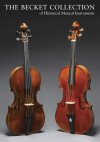Review extracts regarding
 THE BECKET COLLECTION of Historical Musical Instruments
THE BECKET COLLECTION of Historical Musical Instruments
Christopher Reuning The Strad 2010
Though a great many violin –related books have been produced over the last decade, few provide such a broad range of information as is found in this volume. A first encounter may leave the reader grasping for the books overriding theme, but a deeper exploration reveals the book to be much more than just an illustration of the collection itself.
The Becket collection was established but Elise Becket Smith, who had the dream of forming a collection that would constitute a complete orchestra of Classical period instruments. In collaboration with the Royal Academy Of Music, London and with the guidance of David Rattray, curator of the academy’s instrument collection, Becket Smith acquired a remarkable collection of British instruments made at the end of the 18th and the beginning of the 19th centuries. Many of these instruments still retain their original neck and other original accessories. The collection is superbly illustrated with photographs by Clarissa Bruce [and Jonathan Woolston]. Each of the 22 period and 3 modern violins, violas, and cellos is presented with the traditional full front and back views plus a side view of the head. A particularly nice feature is the illustration of the side view of each instrument. The instrument descriptions are concise but provide important biographical and stylistic information about the original features of the instruments…
The next largest component of the book is devoted to the Becket Baroque and the Vivaldi Project. This two-year scheme resulted in a baroque Venetian style orchestra of 14 instruments commissioned from a group of leading contemporary makers. These luthiers copied a diverse group of Venetian instruments and shared information about the baroque period set-up and Venetian constructional design concepts. This collection is illustrated in the same format as the Classical collection.
The remainder of the book is impressive and not to be overlooked. There are no fewer than ten scholarly articles, each related in one way or another to the baroque and Classical periods. They range on David Rattray's commentary on Classical London accompanied by a richly illustrated period map of the city pinpointing
The locations of the old makers and musical venues, to a brief overview of Vivaldi and his music by John Julius Norwich. There is a detailed article by Peter Beare on the Venetian set-up and a fine review on the development of the violin in Britain by Andrew Fairfax. Phillip Kass presents his research on the Dodd family of bow makers and the remarkable Hill collection Classical period bridges is pictured and described. Margaret Faultless and Reinmar Seidler present a brief discussion on period performance and John Dilworth contributes a wide-ranging contribution on the Venetian school and its relevance to modern makers. Finally there are two articles about bows one by Pavlo Beznosiuk on Baroque bows and the other by Brian Tunnicliffe on the bows he made for the Vivaldi Project.
While this book is a useful reference tool for the instruments it contains it deserves a front- to back read before it takes its place on the shelf with the other important violin related books

